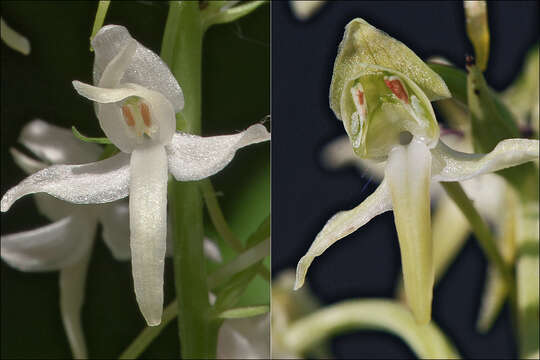Platanthera_chlorantha_5

Description:
Platantera chlorantha (Cust.) Rchb. right side; Platanthera bifolia left. sideGreater Butterfly-orchid, DE: Grnliche Breitklbchen Slo.: zelenkasti vimenjakDat.: June 10. 2008Lat.: 45.94698 Long.: 14.14335Code: Bot_Bot_270/2008_DSC9355Habitat: shallow valley, light mixed wood with dense grassy ground vegetation, half shade, humid place, almost flat terrain, partly protected from direct rain by tree canopies, average precipitations 1.800-2.000 mm/year, average temperature 7-9 deg C, elevation 570 m (1.900 feet), prealpine phytogeographical region. Substratum: soil.Place: ejna dolina (Thirsty valley) near Hotedrica village, Notranjska, Slovenia EC. Protected according to 'Uredba o zavarovanih prostoiveih rastlinskih vrstah'Url. RS, t. 46/2004 (Regulation of protection of wild growing plants, Official Gazette of Republic Slovenia, No.:46/2004). Enlisted in the Slovene Red List of rare and endangered species, marked by "V" representing a vulnerable species.Comment: Platanthera chlorantha is essentially a European orchid with very few disjunct locations in North Africa and Asia. In Slovenia it grows scattered, however, it is less common than it's closely related 'sister' Platathera bifolia (Lesser Butterfly-orchid). Both plants grow in the same habitats, are more or less whitish-greenish, have two or three large ground leaves and are fragrant and their habitus is also similar. It is not always easy to tell them apart in spite of several detailed differences. The most reliable distinguishing trait seems to be orientation and distance between pollinia. Platanthera chlorantha has pollinia widely separated and they lean in towards each other at the tops while Platantera bifolia has them close together and they are vertical and parallel (see Fig. 5, Platanthera chlorantha right, Platantera bifola left). The flowers have very long spurs. Not every insect can reach the nectar in them, they have to have very long proboscis. The main pollinators are moths, which are attracted mainly by flowers' smell. Interestingly, widely separated pollinia of Platanthera chlorantha stick their pollen to moths' eyes when they try to protrude with their heads deep into the long spur. Apparently for orientation smell is more important to them than sight?Ref.:(1) A. Martini et all., Mala Flora Slovenije, Tehnina Zaloba Slovenije (1999) (in Slovene), p 998. (2) www.first-nature.com/flowers/platanthera-chlorantha.php
Included On The Following Pages:
- Life (creatures)
- Cellular (cellular organisms)
- Eukaryota (eukaryotes)
- Archaeplastida (plants)
- Chloroplastida (green plants)
- Streptophyta
- Embryophytes
- Tracheophyta (ferns)
- Spermatophytes (seed plants)
- Angiosperms (Dicotyledons)
- Monocots (Monocotyledons)
- Asparagales
- Orchidaceae (orchids)
- Platanthera (Fringed orchids)
- Platanthera chlorantha (Greater butterfly orchid)
This image is not featured in any collections.
Source Information
- license
- cc-by-nc-sa
- copyright
- Amadej Trnkoczy
- photographer
- Amadej Trnkoczy
- original
- original media file
- visit source
- partner site
- Flickr Group
- ID


